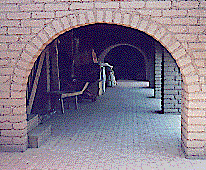1 part white glue such as Elmers
3 to 4 parts water
This prevents dusting, yet the wall can still breath and if it gets wet, the surface dries without leaving water marks. Must be applied to a complete wall at one time. If you stop in the middle and let it dry, there may be a line where you started up again. Apply with a wide brush and work into the joints as you go. This does darken the color of the wall about 10%; however, it also evens out the color between the mortar and the adobe block.
Paint the bond beam, if it is exposed, after the glue coat, so that the colors match. I used Behr Plus 10 Solid Color Stain, # 326 taupe, but this will vary depending on the color of your adobes. I like this stain, which is really a dilute acrylic, because it cleans up with water and soaks in, leaving a thin surface color coat which blends in well next to the adobe.

Finished arch and brick floor
Sealer for brick floors laid in sand
Hillyard CO341Hillyard36 S. 40th PlacePhoenix, AZ USATel: 1-520-884-7372
This is a commercial acrylic sealer. It's relatively expensive, but I recommend it for several reasons:
It sets up the sand between the bricks, so that you can use a vacuum sweeper without sucking up the sand.
It drys to a matte finish which wears well, doesn't need waxing and cleans easily for most spills. Our floors are four years old and I've never waxed or resealed them.
It doesn't darken the bricks.
It cleans up with water and is simple to apply.
The first coat uses a lot more per square foot than the second coat. How much partly depends on how porous your bricks are. We applied this on our hands and knees to get the most efficient coverage.
The bricks tend to chew up sponges and the like. I found some lamb's wool painter's mitts at Home Depot and cut them up into squares. Their texture is like the thick paint rollers. They held a lot of sealer and didn't wear down too fast. Cotton rags will also work.
At the edges of our floors, where the sand joints were wider, we squeezed sealer onto the joints without touching them on the first coat. This set up the sand, and on the second coat, we could go over them directly.
For our workrooms and garages we used cement pavers set in sand. These were much cheaper than brick, faster to lay and don't have to be sealed. I prefer brick and pavers to a cement slab, because if anything goes wrong, it's easy remove a section of the floor, fix the pipe or whatever and put the floor back down.
Sealer for unstuccoed exterior adobe walls
1 part boiled linseed oil
3 parts paint thinner
Our visiting Australian friend, Frank Faulkner, told me that they paint exterior mud brick walls in Australia with linseed oil. We have two walls which are exposed to driving rains during the summer. I've been painting them with dilute linseed oil every two years and it's solved the leaks.
The wall can still breath, so there isn't a problem with water getting behind the coating and causing the surface to spall off. A number of sealers which work on brick, cement stucco or burnt adobe, will cause spalling after a few years on unfired adobe surfaces.
The oil darkens the surface a lot, but it fades back to its normal color over a month or so. Neither of our walls can be seen, so it doesn't matter to us.
I've also read about a product called Bondcrete in the Australian books. I brought a tin home from Sydney, but haven't tried it. It sounds as if it's used as a dilute solution. Anyone with information? March 1998: Bondcrete is okay for interior walls with no water seepage, but not for exterior walls. It has the same problems with spalling off as other sealers.
The least experienced man on an adobe crew usually gets the job of mixing the mortar, including the asphalt. We had a 4-man crew and our 3 best men stayed the whole job, but the Number 4 guys came and went, and they were never as good. The first one didn't get the asphalt mixed in well and with the first heavy rain, I noticed little slumps in the mortar joints in a lot of places. After that, we kept telling whoever was mixing to do it thoroughly, but without complete success.
In a few places, I've had to go back and patch the mortar once the holes got big enough. I wedge small stones into the joints along with the mortar, like they do in Mexico, to help hold it in place and reduce shrink cracks when it dries.
If you don't stucco your exterior walls or protect them with a wide overhang, you may get spalling on any interior plaster from moisture wicking through the mortar joints. This can happen on any single masonry wall, including brick and burnt adobe. We left both our exterior and interior walls unstuccoed. If you do stucco, a plaster that can breath is better on an adobe wall. In Mexico, they use a soft lime
Stain for exterior wood that gets a lot of direct sun - good for large shed and garage doors
1 part linseed oil
2 parts used motor oil
1 part oil-based stain, redwood makes a good color blend
No comments:
Post a Comment